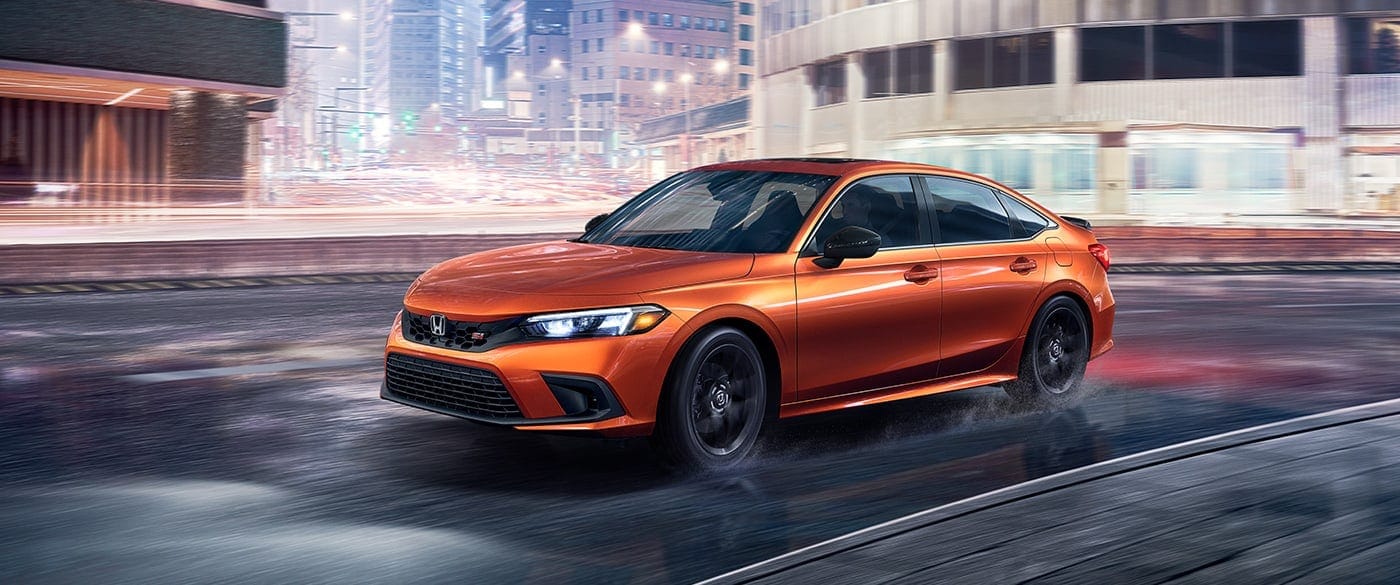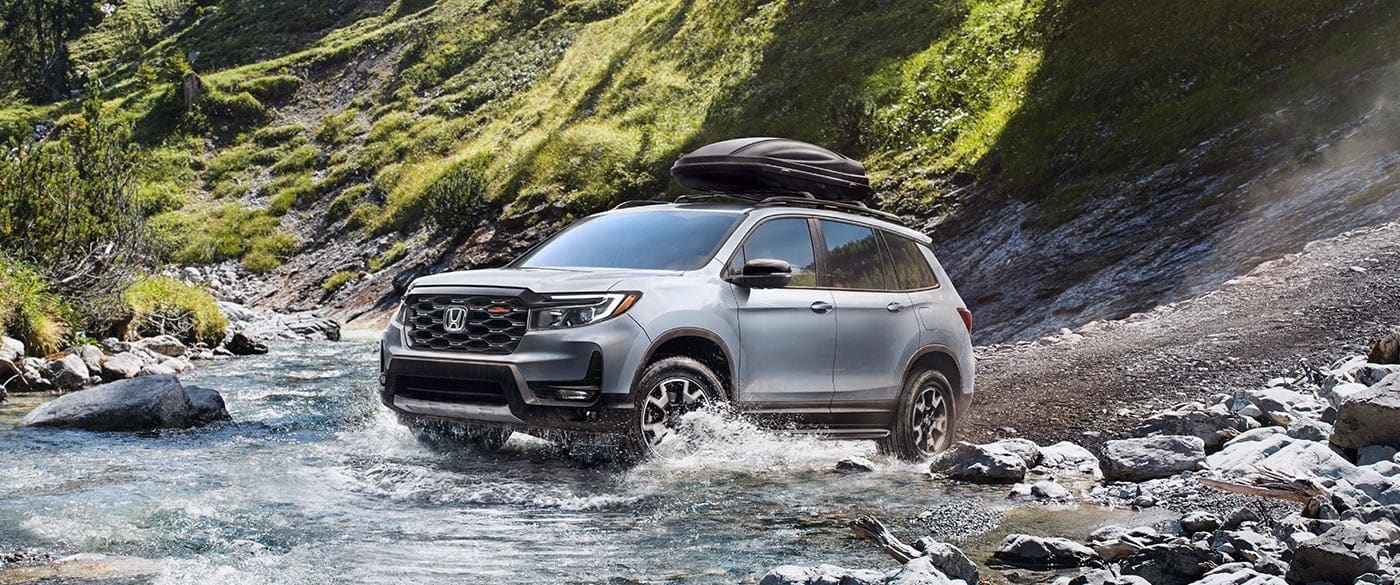
There are many factors that come into play when choosing a new vehicle, and the type of drivetrain is certainly one of them. But for most shoppers, understanding the differences between drivetrains, let alone the benefits of each, is a task in and of itself.
This article will help clear up any confusion by breaking down the advantages and disadvantages of the 4 most common drive systems (front-wheel, rear-wheel, all-wheel and four-wheel drive).
What is FWD?
Front-wheel drive, or FWD, refers to a drive system where the engine's power is sent to the front wheels of the vehicle. This is the most common type of drive system found in cars today, typically smaller, more fuel-efficient vehicles like the 2023 Honda Civic.
One of the benefits of front-wheel drive is that it provides better traction in inclement weather conditions, as the weight of the engine is over the drive wheels. This helps to improve grip and stability on slippery roads. If you live in a cold-weather state that frequently gets snow—including here in Joplin—you'll want to choose a FWD vehicle over a RWD vehicle. Why? In essence, front-wheel-drive vehicles are being pulled, while rear-wheel-drive vehicles are being pushed; there's a reason why we utilize tow trucks instead of plows.
However, one of the drawbacks of front-wheel drive is that it can be less responsive and provide less control for the driver. This is because the front wheels are responsible for both steering and propelling the vehicle, which can lead to understeer (when the front of the vehicle loses traction and continues straight ahead) in high-speed driving situations. This is not likely to occur, however, as most instances of understeering happen when cornering at high speeds or on very slick roads.

FWD: Pros & Cons
Pros:
- Better fuel efficiency compared to other drivetrain types
- Improved handling and traction in wet and slippery conditions
- Lower maintenance and repair costs
- Lighter and more compact, leading to improved handling and weight distribution
- Compared to RWD vehicles, FWD vehicles are better suited for snow and ice
Cons:
- Reduced traction and power compared to other drivetrain types (AWD and 4WD)
- Not ideal for off-road or performance driving
- Prone to steering issues due to their forward-positioned center of gravity
- Can accommodate less payload than RWD, typically
What is RWD?
Rear-wheel drive, or RWD, is a drive system where the engine's power is sent to the rear wheels of the vehicle. This type of drive system is typically found in vehicles that require a lot of power and speed, such as sports cars and trucks. Your newer-model daily drivers aren't likely to have RWD.
One of the benefits of rear-wheel drive is that it provides better handling and control for the driver. This is because the rear wheels are responsible for propelling the vehicle, while the front wheels are responsible for steering. This creates a more balanced distribution of weight, which can lead to improved traction and stability.
However, one of the drawbacks of rear-wheel drive is that it can be less safe in inclement weather conditions, as the weight of the engine is not over the drive wheels. This can lead to oversteer (when the rear of the vehicle loses traction and the vehicle begins to spin) in slippery conditions.

RWD: Pros & Cons
Pros:
- Improved traction and power distribution on dry, normal surfaces
- Enhanced performance and handling capabilities
- More balanced weight distribution
- Ideal for performance driving and racing
Cons:
- Poor traction and control in wet or slippery conditions
- Higher maintenance and repair costs
- More complex drivetrain system
- Oversteering happens frequently if driving too fast around corners
- Heavier weight can cause car components to fail faster than the average
- Tricky handling, especially for new and inexperienced drivers
What is AWD?
All-wheel drive, or AWD, is a drive system where the engine's power is sent to all four wheels of the vehicle. This type of drive system is typically found in larger, more versatile vehicles such as SUVs and crossover vehicles.
Although they're similar to 4WD vehicles, AWD models send power to each wheel independently, allowing them to rotate and travel at different speeds depending on the road and driving conditions. This ensures the most optimal traction, handling and grip to prevent oversteer and understeer. It's the main benefit of driving an AWD vehicle like the Honda Pilot or Passport.
Another benefit of all-wheel drive is that it can provide better off-road capabilities, as it allows for better traction in mud, snow, and other challenging terrain.
However, one of the drawbacks of all-wheel drive is that it can be less fuel-efficient than front-wheel or rear-wheel drive systems, as the power is being sent to all four wheels instead of just two.

AWD: Pros & Cons
Pros:
- Improved traction and control in all driving conditions
- Good handling and stability on rough roads and off-road conditions
- Higher resale value compared to other drivetrain types
- Ideal for all-weather driving and off-road use
- Computer systems control the wheelspin and power so that it's always precise
Cons:
- Reduced fuel efficiency compared to FWD and RWD
- Complex system leads to higher maintenance and repair costs than RWD and FWD
- 4x4 is noticeably better for extreme off-road conditions
What is 4WD?
Four-Wheel Drive, also known as 4WD or 4x4, is a drivetrain system that divides the engine power between all four wheels of the vehicle. Unlike FWD, RWD and AWD, 4WD is designed to provide maximum traction and control in off-road conditions and challenging terrain.
In a 4WD vehicle, the driver can typically manually switch between two-wheel drive (2WD) and four-wheel drive (4WD) depending on the driving conditions. When the driver engages the 4WD system, the vehicle's power is distributed evenly between all four wheels through a transfer case, providing better traction and stability on rough roads and off-road conditions. The transfer case also includes a low-range gear set, which provides additional torque for crawling over obstacles and steep inclines.
Four-wheel-drive is an ideal choice for drivers who frequently drive off-road or live in areas with very challenging weather conditions. The increased traction and control provided by 4WD makes it easier to navigate rough roads and maintain control in slippery conditions.
Although great for off-the-beaten-path driving, 4x4 vehicles aren't without their pitfalls. They are usually very hungry for gas, are more prone to breakdowns due to the environment and are more costly to repair. On top of that, because they are the heaviest of all vehicles, it is more common for 4WD vehicles to flip and roll in extreme circumstances, like accidents or cornering.

4WD: Pros & Cons
Pros:
- Excellent traction and control in off-road conditions and challenging terrain
- Enhanced stability and handling on rough roads
- Versatile and capable, with high ground clearance
Cons:
- Poor fuel efficiency
- Higher maintenance and repair costs
- Heavier weight affects handling and fuel efficiency
- Not ideal for everyday driving on paved roads
- More expensive to buy
- Easier to flip and roll over
- Slow acceleration
What'll It Be?
Unless you're driving on the racetrack or trails, you'll most likely do better with a FWD or AWD vehicle. But you know yourself and your driving habits better than we do! In any case, if you'd like help choosing the best vehicle for your daily commutes or weekend outings, visit our Joplin car dealership to speak with our sales team. Contact Roper Honda at (417) 625-0800 to get a quote and schedule a test drive.